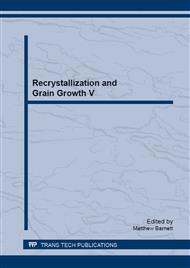p.181
p.185
p.191
p.195
p.201
p.207
p.213
p.217
p.221
Recrystallization and Grain Growth Behavior of few Low Carbon Steels after Severe Cold Rolling and Annealing
Abstract:
Less attention has been paid to study the recrystallization and grain growth behavior of severe plastically deformed (SPD) metals specially steels that are deformed to very high strain by conventional rolling method. Present work has been focused on systematic investigation of recrystallization and grain growth behavior of a Aluminium Killed (AK), an Interstitial Free (IF) and an Interstitial Free High Strength (IFHS) steels that were subjected to very high levels of strain (ԑeqv= 4.51) by cold rolling. The cold rolled steels show fine lamellar structure with very strong texture consists of both γ and α fibre. All the steels show formation of ultrafine grains and dramatic rise in the intensity of α fibre component in the early stages of annealing. However, progress of annealing for longer time leads to an increase in the mean grain size as well as γ fibre intensity. The results also indicate that the heavily cold rolled material exhibit selective growth of specific texture components.It appears that microstructure and texture is closely related to the observed phenomenon.
Info:
Periodical:
Pages:
201-206
Citation:
Online since:
March 2013
Authors:
Keywords:
Price:
Сopyright:
© 2013 Trans Tech Publications Ltd. All Rights Reserved
Share:
Citation:


